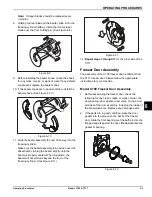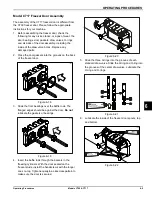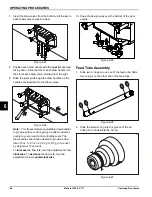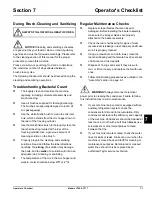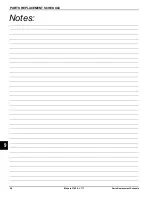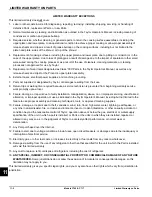
Section 7
7-1
Models C709 & C717
Operator’s Checklist
7
Operator’s Checklist
During Brush-Cleaning and Sanitizing
NOTICE!
Cleaning and sanitizing schedules
are governed by your federal, state, or local regulatory
agencies and must be followed accordingly. Please refer
to the cleaning section of this manual for the proper
procedure to clean this machine.
Please consult your governing food code to determine
the maximum number of days allowed between
brush-clean cycles.
The following checkpoints should be stressed during the
cleaning and sanitizing operations.
Troubleshooting Bacterial Count
Thoroughly clean and sanitize the machine
regularly, including complete disassembly and
brush-cleaning.
Use all brushes supplied for thorough cleaning.
The brushes are specially designed to reach all
mix passageways.
Use the white bristle brush to clean the mix inlet
hole, which extends from the mix hopper down to
the rear of the freezing cylinder.
Use the black bristle brush to thoroughly clean the
rear shell bearing located at the rear of the
freezing cylinder. Use a generous amount of
cleaning solution on the brush.
Properly prepare the cleaning and sanitizing
solutions. Read and follow the label directions
carefully. Too
strong
of a solution may damage
the parts, and too
weak
of a solution will not do an
adequate job of cleaning or sanitizing.
The temperature of the mix in the mix hopper and
walk-in cooler should be below 40
º
F (4.4
º
C).
Regular Maintenance Checks
Replace scraper blades that are nicked or
damaged. Before installing the beater assembly,
make sure the scraper blades are properly
attached to the beater assembly.
Check the rear shell bearing for signs of wear
(excessive mix leakage in rear drip pan) and make
sure it is properly cleaned.
Using a screwdriver and cloth towel, clean the
rear shell bearing and the female hex drive socket
of lubricant and mix deposits.
Dispose of O-rings and seals if they are worn,
torn, or fit too loosely, and replace them with new
ones.
Follow all lubricating procedures as outlined in the
“Assembly” section on page 6-1.
WARNING!
Always disconnect electrical
power prior to cleaning the condenser. Failure to follow
this instruction may result in electrocution.
If your machine is air-cooled or equipped with an
auxiliary refrigeration system, check the
condensers for dirt and lint accumulation. Dirty
condensers will reduce the efficiency and capacity
of the machine. Condensers should be cleaned at
least once a month with a soft brush.
Never
use
screwdrivers or other metal probes to clean
between the fins.
If your machine is water-cooled, check the water
lines for kinks or leaks. Kinks can occur when the
machine is moved back and forth for cleaning or
maintenance purposes. Deteriorated or cracked
water lines should only be replaced by an
authorized Taylor service technician.
ALWAYS FOLLOW LOCAL HEALTH CODES.
Summary of Contents for C709
Page 8: ...1 4 TO THE INSTALLER Models C709 C717 To the Installer 1 Notes...
Page 22: ...4 10 OPERATOR PARTS IDENTIFICATION Models C709 C717 Operator Parts Identification 4 Notes...
Page 58: ...8 4 TROUBLESHOOTING GUIDE Models C709 C717 Troubleshooting Guide 8 Notes...
Page 60: ...9 2 PARTS REPLACEMENT SCHEDULE Models C709 C717 Parts Replacement Schedule 9 Notes...
Page 64: ...10 4 LIMITED WARRANTY ON EQUIPMENT Models C709 C717 Limited Warranty on Equipment 10 Notes...
Page 68: ...11 4 LIMITED WARRANTY ON PARTS Models C709 C717 Limited Warranty on Parts 11 Notes...



